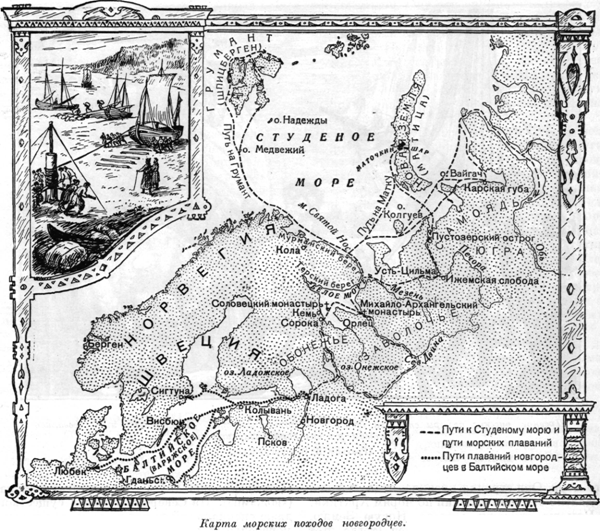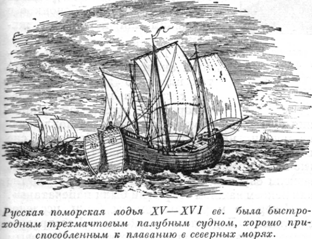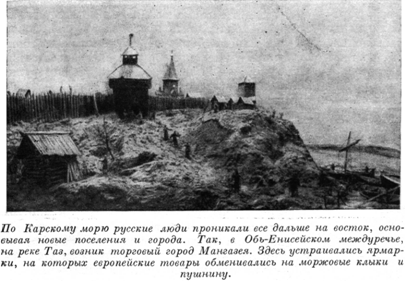Ancient legends and chronicles told people that the path to the Far North was laid by sailors for hundreds of years. Probably, light ships of the Normans were in the waters of the "Cold Sea" about 1000 years ago. But reliable information about this has not been preserved. Russian chronicles say that hundreds of years ago, Pomors, settlers on the shores of the White Sea and the Kola Peninsula from Novgorod, walked along the harsh waters of this sea. Courageous, free from the yoke of serfdom, the Novgorod peasants united in squads and went to unknown lands for precious furs, to fish and sea animals.
The tenacious hands of the boyars and the sovereign's servants did not reach the distant shores of the White Sea. Ordinary people went to the North not only from the lands of Veliky Novgorod. Peasants from the central and northwestern regions of the country fled here to get rid of the master's oppression, unbearable extortions and debt bondage.
In the XII-XV centuries. Novgorodians explored and mastered the coast of the Kola Peninsula, the shores of the White Sea. They built strong ships and traveled far from their villages on the seas of the Arctic.
Pomors discovered the islands of Novaya Zemlya, Kolguev, Medvezhiy, Svalbard (then this archipelago was called Grumant's Land).
Often the brave coast-dwellers had to stand up to defend the lands they had mastered, which foreigners began to covet.
The Russian North has long been a lively trading place, where foreign merchants from Western Europe flocked. They bought here precious furs, fat and skins of marine animals, walrus tusks and other goods that were delivered from Western Siberia by land, through the polar Urals, and by sea.
In voyages to the east along the "Arctic Sea", Western European travelers, as a rule, used the help of Russian sailors. The first Russian pilots appeared on the Neva and Volkhov during the time of Veliky Novgorod.
They were then called ship leaders ("leaders"). In the North, in Pomorye, there was even a special horse-drawn trade and artels of ship-leaders.
Russian sailors went far into the depths of the seas. On the islands of the Arctic, researchers many times found the remains of Russian Pomeranian winter quarters and their fishing equipment. Known to explorers of the Russian North is the Pomor Ivan Starostin, who settled for many years on Grumant (Svalbard). It was mastered by the Russians on Medvezhiy Island. Foreigners even called its northern coast "the Russian coast".
Russian coast-dwellers laid the foundation for a new type of navigation - ice. They managed to explore not only the European North, but also a significant part of the Asian coast.
The study of the ships of the ancient Novgorodians and Pomors, who settled in the North, showed what abilities and ingenuity the first Russian Arctic sailors possessed.

Russian sea boat of the 16th century. could take on board 200 tons of cargo. It was a three-masted deck ship with straight sails. Smaller boats, with a deck and two masts, were usually intended for navigation on the White Sea. Pomors sailed on ships of other types. The most ancient ship is the kochmara, or koch, a three-masted deck vessel. By design, the koch is very similar to the boat, only it is smaller in size. Pomors and simpler types of ships were built: ranshins, augers and karbas.
On some types of ships, the Pomors attached the skin to the ship's hull with the help of juniper roots. In some cases, northern shipbuilders preferred a wick to iron nails, as they were convinced by experience that it was more reliable than iron. Sheathing sewn with vice was more watertight than that fastened with iron nails. When sailing in the ice, the ship's hull loosened and leaked in places where there were nails. In addition, the nails quickly rusted and destroyed the skin. With a wooden fastening, the vice, swelling, almost did not let water through at all. Sheathing boards, sewn to the frame of the ship in a special way, held tight.
In addition to juniper, a young thin spruce up to one and a half meters high served as a material for wooden "threads". The trunks of such Christmas trees were cleaned of branches, twisted and dried. They were steamed before use. With such "threads" the lodya was sewn. The master's set of tools usually consisted of an ax, a saw, a drill, a level and a sazhen, broken into arshins and vershoks. Ships were built on the banks of the river, near the customer's house. Immediately with a pole on the sand or in a hut with chalk on the floor, the master made a drawing and made the necessary calculations. First, the frame of the vessel was built, which was then sheathed with boards outside and inside. Then they put and fastened high straight masts and laid the deck.
A large ship - a lodya - was built by an artel of carpenters in one winter.


By decree of Ivan the Terrible, the first large shipyards and even a dry dock were built at the Solovetsky Monastery for the construction of ships on the White Sea.
In ancient times, sails on Pomeranian ships were sometimes made of suede - deer skin treated with the fat of a sea animal. Sea hare skin was used for belt gear.
The boats had a flat wide bottom and a small draft, so when sailing in the ice to "unprecedented lands" they did not need special harbors in order to hide from the storm or spend the winter. Sometimes Pomors had to pull their boats onto the ice or onto the shore. With all these advantages, Pomeranian ships also had their drawbacks: they were worse than keel ships, they obeyed the helm, especially in waves.
Sailing the Arctic Ocean with its harsh climate, heaps of ice and unknown currents was a good school for sailors. Hardy and courageous, not afraid of hard frosts and strong winds, Pomors boldly embarked on long voyages along the stormy waves of the ocean on their small wooden ships.
In the daily struggle with the elements, the Pomors have studied the "Cold Sea" well. They knew that the magnitude of the ebb and flow is related to the position of the Moon in the sky, and they figuratively called the tidal phenomena "the sighs of the sea-ocean."
“His chest is wide, powerful,” they said, “when he sighs, he lifts his chest, then the water has arrived: the tide means. Exhale - the water leaves: the ebb comes. The ocean-father does not breathe often: he inhales twice, exhales twice - the day will pass.
The Pomors knew the compass, which they called the queen. They have long recognized time by the sun and stars.
The winds, depending on the direction, they also called in their own way. "Midnight", for example, was called the northeast wind; "sholonnik" - the wind blowing from the southwest; "coastal" - northwest wind; "Luncher" - southeast. Russian sailors studied not only winds, but also currents, ebbs and flows, and the state of the ice.
They knew well and used local remedies against scurvy: cloudberry, spoon grass, raw meat and warm blood of animals. Northern sailors from ancient times had handwritten maps-drawings and handwritten directions, which briefly described the sea coast, indicated profitable and safe routes and the best time for sailing ships.
The oldest handwritten sailing directions had such headings: "Charter as a Vessel to Drive", "Ship Progress of the Russian Ocean-Sea", "Progress of the Grumanlandskaya".
Sailing along the White Sea and the Arctic Ocean developed dexterity, unique methods of controlling a ship. Pomors improved their experience and passed it on from generation to generation. If, for example, the wind strongly heeled the boat, threatening to instantly capsize it, the Pomor threw a sharp ax or knife into the sail, and then the wind tore the sail to shreds, and the boat leveled off.
Northern sailors have long used blubber as a means of calming unrest. On the ships of the Pomors, there were always several barrels of seal or seal oil in stock.

In 1771, the well-known Russian academician I. I. Lepekhin wrote about it this way: “This remedy consists in blubber fat, which, while the ship is splashing, is poured into the sea, or sacks filled with it are let near the ship. This tool has been known to our Pomeranians since ancient times and for many years before they were in use, rather than European departments about this tool as some important discovery were published. Northern sailors-Pomors were explorers of the Arctic Ocean. Fearlessly setting sail on the unknown harsh seas, they made valuable geographical discoveries.
